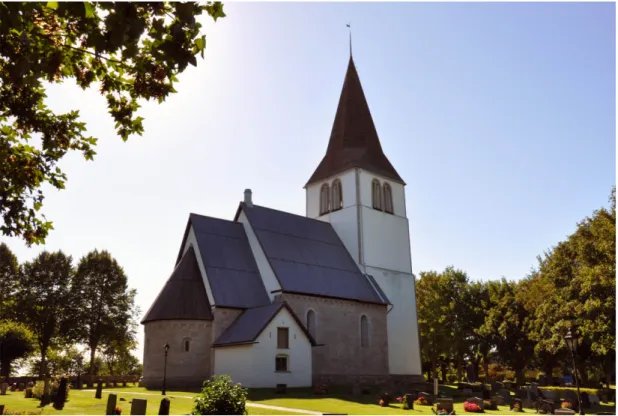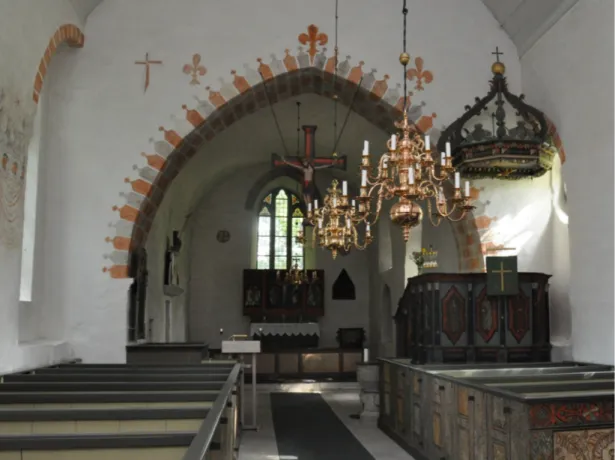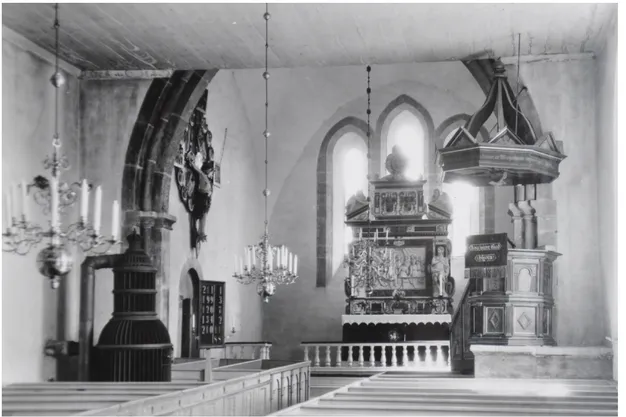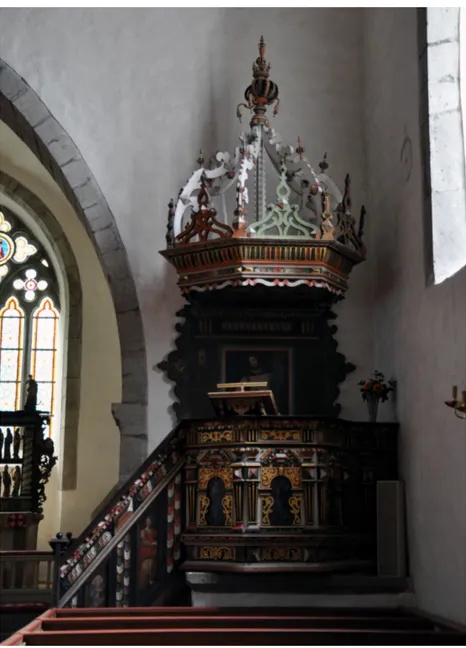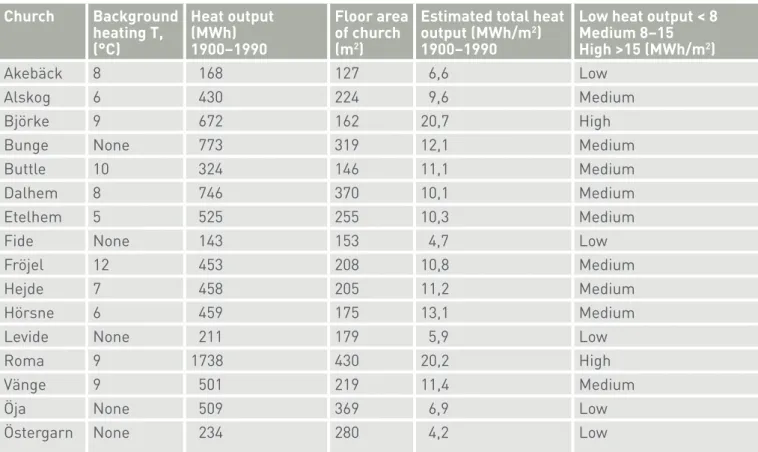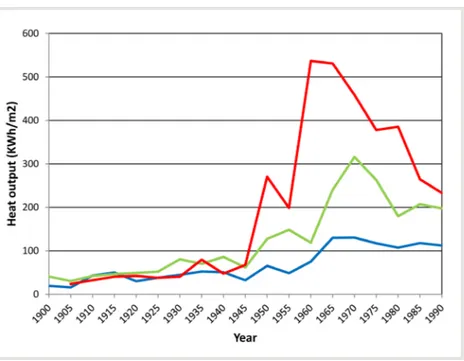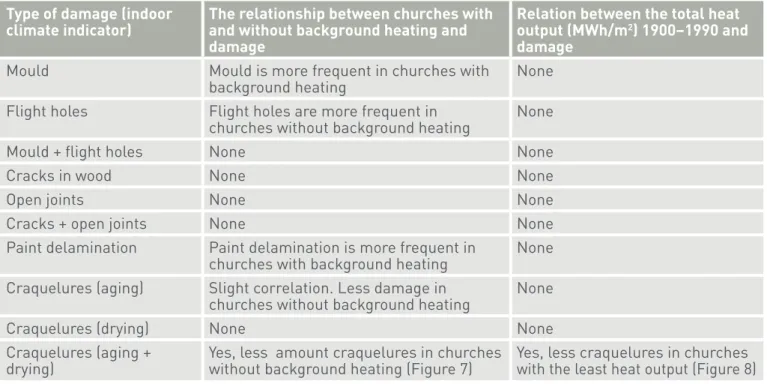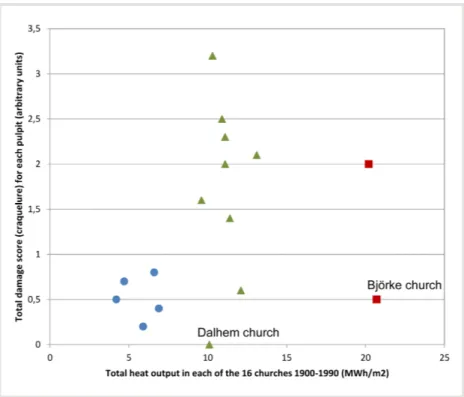Abstract
this paper describes and applies a method to quantify and relate damage of painted wooden pulpits in 16 churches in Gotland, sweden, to both the current and the historical indoor climate of the twentieth century. in addition, it demonstrates that the energy used to heat a church in the past can be measured and the study also points towards a relationship between damage and heat output. the results suggest that more damage is present in churches with a higher heat output and there is increased damage in churches using background heating compared to churches that do not. however, the method needs to be improved and a larger population is required to validate these results.
Introduction
one of the most challenging tasks today in the cultural heritage sector is to determine the influence of present and future climates on historic buildings, interiors and collections. some of the objectives of the ongoing european seventh framework Program Climate for Culture (CfC), Work Package (WP) 4, damage assessment are to increase knowledge about the cause-effect relationship between indoor environment, relative humidity (rh) and temperature (t) and the state of preservation of collections. this includes determination of tolerable rh and t ranges for different materials as well as the correlation between the historic climate and state of preservation [1]. laboratory studies [2], mock up studies in museums [3] as well as studies of single objects in historic buildings and modelling [4] have been performed. however, to further validate these results complementary surveys of larger numbers of object types in their actual historic microclimates are also needed. this is emphasised in the
subproject, CfC WP 4.1, statistical assessment of actual damages in relation to indoor climate in a representative population of historic buildings. such surveys will add relevant information to the research area of climate-induced damage, but the subject is also very complex, which is probably one reason why they have been performed only in limited numbers.
there are many possible uncertainties in the cause-effect relationship between the deterioration of organic materials and their indoor environments and so it is difficult to draw reliable, comparative conclusions. the cause, both the set point and short-term fluctuations of RH and T will have varied over time and cannot be isolated from other influencing factors such as light and air pollution. even if rh and t records are available from the churches over certain periods, there is no useful way of quantifying the indoor climate, either in the present time or from a historic perspective. the effect on objects of organic materials, their constituents, age, manufacturing techniques and history is the sum of the visible, permanent damage and change; hence the
Quantification, the link to relate climate-induced
damage to indoor environments in historic buildings
Charlotta Bylund Melin and Mattias Legnérstate of preservation of the objects as seen today is the sum of all those cumulative factors from the past. due to the lack of methods to quantify the historic and present indoor climate as well as the damage and change of objects, it is not possible to relate these two parameters to each other.
the island of Gotland is located in the Baltic sea, about 90 km from the swedish coast. its central position in the Baltic has made it an important harbour, which has promoted trading and resulted in long periods of great wealth. from the twelfth century until c. 1350, 92 churches were erected on the island, constituting a cultural heritage of great value. Both the exteriors (figure 1) as well as the interiors (figure 2) of these churches have many similarities. the churches are all located within an area of less than 3184 m2
and are exposed to the same oceanic climate. they are all made of local sandstone or limestone and all interior walls are rendered and the ceilings and floors are stone or partly of wood. In the late sixteenth century, pulpits and other furnishing associated with lutheran liturgy were introduced to the churches. due to their high cultural heritage value, major works undertaken in the churches, such as restoration and renovation of interiors or the introduction of new heating systems, have been systematically recorded since the 1920s. When the objects in these churches are examined it is possible to observe damage which can be related to the indoor environment, although the extent varies between churches. this is particularly noticeable on painted wooden objects. one reason for this may be the differences in indoor climates between churches, but until now the heat output (energy used for space heating) over a long period of time has not been connected to the climate-related damage observed in churches.
the aim of this pilot study is to propose an interdisciplinary approach to investigate whether a set of pre-selected damage patterns which are known to be caused by fluctuating and high rh and t (indoor climate indicators), in combination with
figure 1. levide church, a typical Gotland church
documentation on historic heating can be used as proxies [5] for the historic indoor climate.
the hypothesis is that by studying and comparing a large number of similar, immovable objects in indoor environments which do not accord with recommendations on museum climates [6] it should be possible to distinguish patterns of damage caused by different climate conditions. although the approach will give an approximation only, the damage will be able to provide indications of past and present indoor environments.
from a research perspective, the Gotland churches are a good model base for population studies. the method used for this survey was to assess damage in 16 of the 92 churches. these particular churches were selected to represent the different heating regimes used in Gotland churches. Heating of the nave was first introduced in rural Gotland churches around 1900. the oldest kind of heat source was the Gurney´s oven (figure 3).
When central heating (Ch) was introduced it was usually in the form of low-pressure steam that gave off an intense heat and was difficult to control. In the 1940s to 1950s, older CH systems were, with a few exceptions, replaced by either low-pressure hot water or electrical space heaters.
the objects chosen for the survey were pulpits (figure 5). they are commonly found in the churches and on Gotland they are made of local wood (normally pine). they were originally painted polychrome using oil paint [7]. in the majority of the churches they are located in their original positions e.g., the south-east corner of the nave, and have only on rare occasions been moved. the pulpits are fully or partly freestanding, avoiding microclimate conditions which can develop around objects in close contact with an exterior wall.
figure 2. interior of Buttle church with the pulpit in the south-east corner of the nave
Method
By studying a population of similar objects which have not been moved from their original environments it may become possible to relate specific damage patterns to certain indoor climates. In this context it becomes more important to study a large number of objects rather than looking at individual objects and buildings. This section will briefly describe the methods for 1) quantification of energy used for heating and 2) the survey of indoor climate indicators for wood and painted layers.
Heating
until now, the past heating of historic buildings has rarely been studied [5, 8]. evidence-based knowledge is largely lacking, despite the prospect of researching past energy use in churches being relatively good in sweden [9, 10]. in general, data on past indoor t and rh in churches are not available, which is also the case for the 16 churches studied. in order to document how the indoor climate may have fluctuated in a church, archival sources are used, which provide indications of what the climate was like. documentation on heating systems and historic fuel consumption is available for almost all of the churches. the information on heating systems is held by Antikvariskt-Topografiskt Arkiv (ATA) and can also be found in management plans kept at Gotland’s museum. in some cases when management plans proved incomplete, it was possible to use parish records to fill in the gaps. Parish accounts, which contain data on fuel consumption, are available through Visby arkivcentrum.
The first step in this research was to identify the different kinds of heating used in the churches and map when alterations were made. the next step was to extract data on how much fuel (and energy) each system used. the accounts of each parish were consulted for this purpose. For each five-year interval, one year
figure 3. fröjel church. opposite the pulpit is a Gurney type of oven located in the north-east corner of the nave. source: ata, the national heritage Board (photographer: h. faith-ell, 1931)
was examined: 1900, 1905, 1910, etc. fuel consumption in the parish accounts was then converted to efficiency, measured in watts/hour (kW/h). Each kind of fuel has a specific energy content given by the swedish environmental Protection agency.
having established information on annual energy consumption, the amount of energy utilised (efficiency) then had to be estimated in order to quantify the output. some of the energy consumed is lost in the process and does not add to heat introduced to the building [11]. in the end, these calculations give a total estimate of how much energy was added to the heating of the church between the years 1900 and 1990 (table 1). these values were then divided by the area of the church in order to compensate for the volume heated. As data on the volume of spaces was missing, floor areas were used instead. A large floor area indicates a voluminous church. Finally, the total heat output was multiplied by five since only every fifth year was examined. In the last column in table 1, the total heat output values are divided into three groups, low, medium and high so they can be compared. the estimates for background heating (table 1) should be viewed as approximate figures as the temperature has most certainly varied significantly in reality.
today, all churches are heated intermittently but there was no rh control in any of them before the 1990s. data on background heating, used in 11 of the 16 churches, was obtained from the parishes. The other five churches are allowed to cool down between the sermons. a sudden rise in heat output (figure 6)
indicates a drastic change of the heating regime, for example the introduction of background heating, or it could relate to one or several extremely cold winters. as seen in figure 4, the winters of the 1910s and 1920s were unusually cold, and the winters during World War ii (when churches were rarely heated) were very cold. there were also a few very cold winters in the mid-1980s. on the other hand, a considerable drop in energy output would indicate a shift in heating regime or one or more mild winters.
Damage and selection of indoor climate indicators
damage assessments as well as risk assessments are used in the field of conservation to quantify the condition of collections. Both the terms ‘risk’ and ‘damage’ are related to a change in value and usefulness. However, these factors may influence the overall assessment and hence the outcome of the survey [12, 13]. methods of using more focused indicators have been used for specific purposes by Bucklow [14], Brunskog [15, 16] and Bylund melin et al. [17]. in the present damage assessment, the pulpits are regarded strictly as a population, subjected to climate-induced damage and the indicators are simply recorded and quantified without further interpretation. observed examples of damage
figure 4. annual average temperature of stockholm 1756– 2011 (reconstructed data). source: smhi (www.smhi.se)
visible to the naked eye or by using a handheld microscope were utilised in the survey and the following indoor climate indicators for wood and paint were selected by the experience gained from an earlier pre-study.
the pulpits consist of interlinking wooden elements, which can become visibly deformed as the elements can act as restraints on each other. Visible signs of mechanical deformation are cracks, open joints and shrinkage, as revealed by unpainted edges where the wooden elements overlap.
flight holes from wood-boring beetles are common in wooden objects in the Gotland churches, although it is not always possible to judge infestations are ongoing or historic [18]. from the archive records, it is obvious that infestation has been a problem in the Gotland churches for decades or even longer and measures were regularly taken to remove them.
mould hyphae are visible on some pulpits and were recorded although strictly speaking the mould is causing the damage, it is not the damage itself. the visible hyphae can be, and have been, removed and so cannot be regarded as permanent damage.
figure 5. the pulpit in hörsne church
originally the pulpits were painted with polychrome oil paint [7]. the extent to which hide glue, gesso grounds or varnish were used is uncertain. today, remains of a white ground are visible in some areas, while other parts of the same pulpit exhibit no traces. the pulpits have also been repainted and restored on one or several occasions, which is also supported by archive records. active delamination of the paint layers is only rarely seen.
In contrast, a network of fine cracks (craquelures) perpendicular to the paint surface is often visible in the painted surface. drying cracks (developed during the drying of the paint) would show random craquelure patterns while aging cracks (developed in the older and more brittle paint layers) present craquelure patterns more parallel to the grain of the supporting wood [19]. Both these types of craquelures are present on the pulpits. as aging cracks can be related to the moisture movement of the wood, the two types were recorded separately. mecklenburg [19] and Bucklow [20] have pointed out that oil paints containing different pigments have different rh-related mechanical and dimensional properties. it was clear that this phenomenon was present as adjacent areas of surface painted with different colours could show different craquelure patterns or amounts of craquelures. therefore the damage assessment was also performed using the craquelure patterns for the most common colours in the pulpits, e.g. white/ light grey, brown, black, red, skin colour (carnation), blue and green. each colour was not present on all pulpits and the size of each coloured area varied among the pulpits.
it was important to quantify the damage so comparisons could be undetaken. methods like detailed photographing of the painted
Church Background heating T, (°C) Heat output (MWh) 1900–1990 Floor area of church (m2)
Estimated total heat output (MWh/m2)
1900–1990
Low heat output < 8 Medium 8–15 High >15 (MWh/m2)
akebäck 8 168 127 6,6 low
alskog 6 430 224 9,6 medium
Björke 9 672 162 20,7 high
Bunge none 773 319 12,1 medium
Buttle 10 324 146 11,1 medium
dalhem 8 746 370 10,1 medium
etelhem 5 525 255 10,3 medium
fide none 143 153 4,7 low
fröjel 12 453 208 10,8 medium
hejde 7 458 205 11,2 medium
hörsne 6 459 175 13,1 medium
levide none 211 179 5,9 low
roma 9 1738 430 20,2 high
Vänge 9 501 219 11,4 medium
Öja none 509 369 6,9 low
Östergarn none 234 280 4,2 low
table 1. Present background heating and total heat output in the 16 Gotland churches. the estimated total heat output values (mWh/m2) are multiplied by five to compensate for the years that were not examined
surfaces, computer monitoring and calculating of damaged surfaces in relation to undamaged etc. were discussed but were considered unhelpful because some areas were too small to register or did not have distinct borders. from the experience of the earlier pre-study of the pulpits it seemed possible for the examiner to make a subjective quantification. The quantifications were made as blind tests as the specific heating systems of the churches were not known during the assessment. only the naked eye, an led-torch and a handheld microscope were used for the inspections. it was decided to use four grades on a relative scale to quantify the damage:
0 points = no damage
1 point = small number of damaged areas 2 points = medium number of damaged areas 3 points = large number of damaged areas
each damage pattern was inspected on all sides of the pulpits before registering the score and an average of 20 to 30 areas were observed before deciding the final score. In some instances the incoming daylight from the south-facing windows had caused increased deterioration of the paint on one side of the pulpits so those sides were excluded from the survey:
Results
it has been shown that the degree of heating in churches has varied over time, and that these variations can be tracked by using archival sources. this means that it is not necessary to speculate how a particular church was heated in the past. figure 6 shows the fluctuation in heat output for each five-year interval in the 16 churches. the general tendency is that there was a low and stable heat output during the first half of the century. After World War II there was a strong increase in heat output. it is also noticeable that the larger the total heat output, the larger the fluctuations. table 1 shows that there is a relationship between present background heating and total heat output, e.g., churches without background heating generally show low heat output.
figure 6. the heat output for every fifth year in the 16 Gotland churches, 1900–1990. the red curve is the average values of the churches with high total heat output
(> 15 mWh/m2),
the green curve is the average of the churches with medium heat output (8–15 mWh/m2) and
the blue curve low heat output (< 8 mWh/m2),
table 2. the relation between the indoor climate and damage
the damage as an individual parameter or in combination was related to indoor climate variables as seen in table 2. it is known that permanent heating in historic buildings has caused incalculable damage to painted wooded objects [21] if the relative humidity is not controlled.
When the different background heating temperatures were compared (5 to 12 °C) with the condition of the pulpits it had been assumed that higher temperatures would cause more damage. no relationship was identified, however. By dividing the churches into two simple groups, those with and without background heating, a clearer pattern emerged; more damage craquelures were observed in churches with background heating (figure 7).
this tendency was clear for all colours, except green, on all pulpits. making the same type of comparison between the different colours and the total heat output did not show the same relationship. however, a comparison of the three levels of total heat output with the total damage scores for all craquelures of all colours for each pulpit showed lower damage scores in churches with lower heat output when compared with those with medium heat output (figure 8). the same relationship is also found in churches with and
without background heating. there is also an increased frequency of paint delamination in churches with background heating. No such relationship was identified for mechanical deformation of the wood. for mould, an increase was found in churches with background heating whereas flight holes were more frequent in churches without background heating.
Discussion
there is a large number of variables among the churches such as volume, heating systems, presence of moisture-buffering materials and different air leakages due to the building envelope.
Type of damage (indoor
climate indicator) The relationship between churches with and without background heating and damage
Relation between the total heat output (MWh/m2) 1900–1990 and
damage
mould mould is more frequent in churches with
background heating none
flight holes flight holes are more frequent in
churches without background heating none
Mould + flight holes none none
Cracks in wood none none
open joints none none
Cracks + open joints none none
Paint delamination Paint delamination is more frequent in
churches with background heating none
Craquelures (aging) slight correlation. less damage in
churches without background heating none
Craquelures (drying) none none
Craquelures (aging +
figure 7. the relation between damage score of the different colours on the pulpits in the 16 churches with and without background heating. for all colours, except green, there are more craquelures (higher damage score) in churches with background heating (red bars) compared to churches without (blue bars). for red and carnation colours there are no craquelures in churches without background heating and hence no blue bars in the diagram
figure 8. the relation between the total heat output (mWh/m2) and total
damage score for craquelures of all colours of each pulpit in each church. the group of red squares are the damage scores from pulpits in churches with high heat output as presented in table 1 (> 15 mWh/m2). Green
triangles are pulpits representing medium heat output (8 to 15mWh/m2)
and blue circles are low heat output (< 8 mWh/m2). the two outliers,
dalhem and Björke churches showing low damage scores have pulpits which were repainted by the same painter, C. W. Pettersson, as late as the beginning of the twentieth century and therefore craquelures may not yet have developed
furthermore, the variety of the pulpits in terms of age, method and number of restorations and the lack of knowledge about the exact constituents of the paint layers and so on could be used to argue that a survey like the one presented in this paper is not valid. Despite this, slight relationships have been identified which suggest that the approach of relating past indoor climate to indoor climate indicators is a method that could be further developed. many questions have arisen during the survey; are all damage patterns studied here useful, should some be excluded or others included? the survey indicates that the craquelure patterns are the most useful of damage patterns explored as they present a large degree and range of quantifiable damage. It can be dangerous to make such assumptions as it also indicates that the damage in wood might prove useful if a larger population was incorporated. is it possible to neglect other agents of deterioration like light and air pollution from a survey like this? the light levels in the buildings should also be taken into account, as well as variations in outdoor climate conditions.
there seems to be a relationship between low damage scores and churches without background heating and with low total heat output. this supports the assumption that saving energy in the churches by not using background heating also benefits the preservation of the paint layers on the pulpits.
Perhaps the most important intention of this survey was to find an affordable and efficient method to make assessments of past indoor climate and damage inflicted that can be compared between a large number of locations. therefore the weakest part in this survey is the damage assessment. To find a method for quantification of damage that is both objective and reproducible, Bucklow [14] suggests having a set of reference standards which can be used even by inexperienced conservators or art-historians to assess craquelure patterns. something similar may be
applicable though it would need to be developed by experienced conservators. it would also be valuable to make similar
assessments of other groups of materials.
Our study shows that there are many difficulties to overcome and that the method presented here should be further developed and improved. however, measuring both the cause and the effect allows them to be quantified and compared. Further studies relating actual monitored relative humidity and temperatures to known energy consumption and heat output in different churches would demonstrate if the archive records proxies were reliable. in this respect, simulations of the indoor environment could prove useful. for both the proxies as well as the indoor climate indicators a larger population would validate the methods as well as the results.
Acknowledgments
the authors would like to thank the swedish energy agency. thanks also to the swedish research Council, syskonen Bothén stiftelse and svea orden for funding parts of the research, and to painting conservators Carl-henrik eliasson and nadine huth, Gotland, Jacques de maré, department of mathematical sciences, Chalmers/university of Gothenburg, uwe nolt, vti, hamburg.
References
[1] Climate for Culture website, http://www.climateforculture.eu/ (accessed 30 august 2012).
[2] mecklenburg, m.f., tumosa, C.s., and erhardt, d., ‘the
changing properties of aging oil paints’, material research society symposium Proceedings 852 (2005) 12–24.
[3] van den Brink, o.f., eijkel, G.B., and Boon, J.J., ’dosimetry of paintings: determination of the degree of chemical change in museum-exposed test paintings by mass spectroscopy’, termochimica acta 365 (2000) 1–23.
[4] Bratasz, L., Jakiela, S., and Kozłowski, R., ‘Allowable thresholds in dynamic changes of microclimate for wooden cultural objects: monitoring in situ and modelling’, in iCom Committee for
Conservation, 14th triennial meeting, Preprints, ed i. Verger, James & James, london (2005) Vol. ii 582–589.
[5] Cassar, m., and taylor, J., ‘a cross-disciplinary approach to the use of archives as evidence of past indoor environments in historic buildings’, Journal of the society of archivists 25.2 (2004) 157–172. [6] thomson, G., the museum environment, 2nd edn, Butterworth, london (1986).
[7] eliasson, C-h., private painting restorer, Gotland, personal communication, september 2011.
[8] legnér, m., ‘on the early history of museum environment control: nationalmuseum and Gripsholm Castle in sweden, c. 1866–1932’, studies in Conservation 56 (2011) 125–137.
[9] legnér, m., ‘tracing the historical indoor climate of a swedish church, c. 1800–2000’, aPt Bulletin Xliii (2012) 49–56.
[10] legnér, m., and Geijer, m., ‘heating regimes in old swedish churches, c. 1880–1980’, in Paper for the 2nd european Workshop on Cultural heritage Preservation, oslo 24–25 september 2012 [in print].
[11] rietschel, h., and raiss, W., lehrbuch der heiz- und lüftungstechnik, springer Verlag, Berlin (1960).
[12] ashley-smith, J., risk assessment for object Conservation, Butterworth heinemann, oxford (1999).
[13] taylor, J., and stevenson, s., ‘investigating subjectivity within collection condition surveys’, museum management and Curatorship 18.1 (2000) 19–42.
[14] Bucklow, s., ‘a stylometric analysis of craquelure’, Computers and the humanities 31 (1998) 503–521.
[15] Brunskog, m., ‘Japanning in sweden 1680s–1790s.
Characteristics and preservation of orientilized coatings on wooden substrates’, Göteborg studies in Conservation 11, acta universitatis Gothoburgensis, Göteborg (2004) [dissertation].
[16] Brunskog, m., ’Paint failure as potential indicator of cool indoor temperature’, in Postprints from the Conference energy Efficiency in Historic Buildings, Visby, February 9–11, 2011, ed. t. Broström, l. nilsen, Gotland university Press, Gotland (2012) 30–36.
[17] Bylund melin, C., Bjurman, J., Brunskog, m., and von hofsten, a., ‘Painted wood as a climate indicator? experiences from a condition survey of painted wooden panels and environmental monitoring in Läckö Castle, a dehumidified historic building’, in multidisciplinary Conservation. a holistic view for historic interiors, rome 23–26 march 2010. iCom-CC interim meeting, ed. m.
sawicki, iCCrom, rome, http://www.icom-cc.org/54/document/ painted-wood-as-a-climate-indicator--experiences-from-a- condition-survey-of-painted-wooden-panels-and-environmental-monitoring-in-lck-castle-a-dehumidified-historic-building/?id=817 (accessed 14 august 2012).
[18] nolt, u., Johann heinrich von thünen institute, hamburg, personal communication, 12–13 may 2012.
[19] mecklenburg, m. f., ‘determining the acceptable ranges of relative humidity and temperature in museums and galleries. Part 1 structural response to relative humidity’, http://www.si.edu/ mci/downloads/reports/mecklenburg-Part1-rh.pdf (accessed 31 august 2012).
[20] Bucklow s., ‘Pigment-medium interaction: visible evidence’, in deterioration of artists´ Paints: effects and analysis. a joint meeting of iCom-CC Working Group Paintings 1 & 2 and Paintings section, uKiC. extended abstracts of presentations. British museum, london (2001) 49–52.
[21] tångeberg, P., ’skador på måleri i svenska kyrkor. en lägesrapport. restaureringsprinciper’, fornvännen 74 (1979) 113–125 [in swedish].
Authors
Charlotta Bylund is a conservator and currently a Phd student at the university of Gothenburg, department of Conservation. e-mail: charlotta.bylund-melin@conservation.gu.se
Mattias Legnér is associate Professor in Conservation at Gotland university, Visby. e-mail: mattias.legner@hgo.se.
Image credits
figures 1, 2 and 5. Photographer: Charlotta Bylund melin figure 3. Photographer: h. faith-ell, 1931
Licence
this publication is licensed under a Creative Commons attribution – noncommercial – no derivative Works 3.0 unported licence. to view a copy of this licence, please visit
